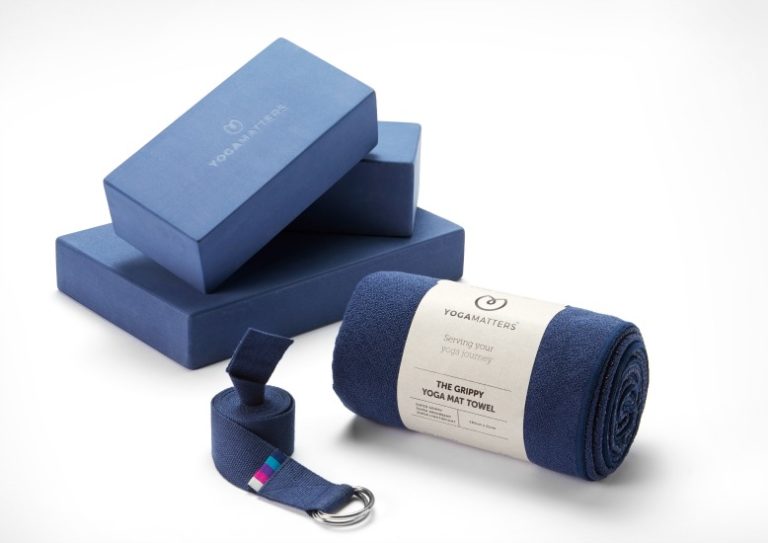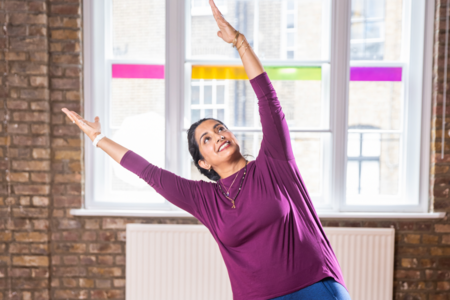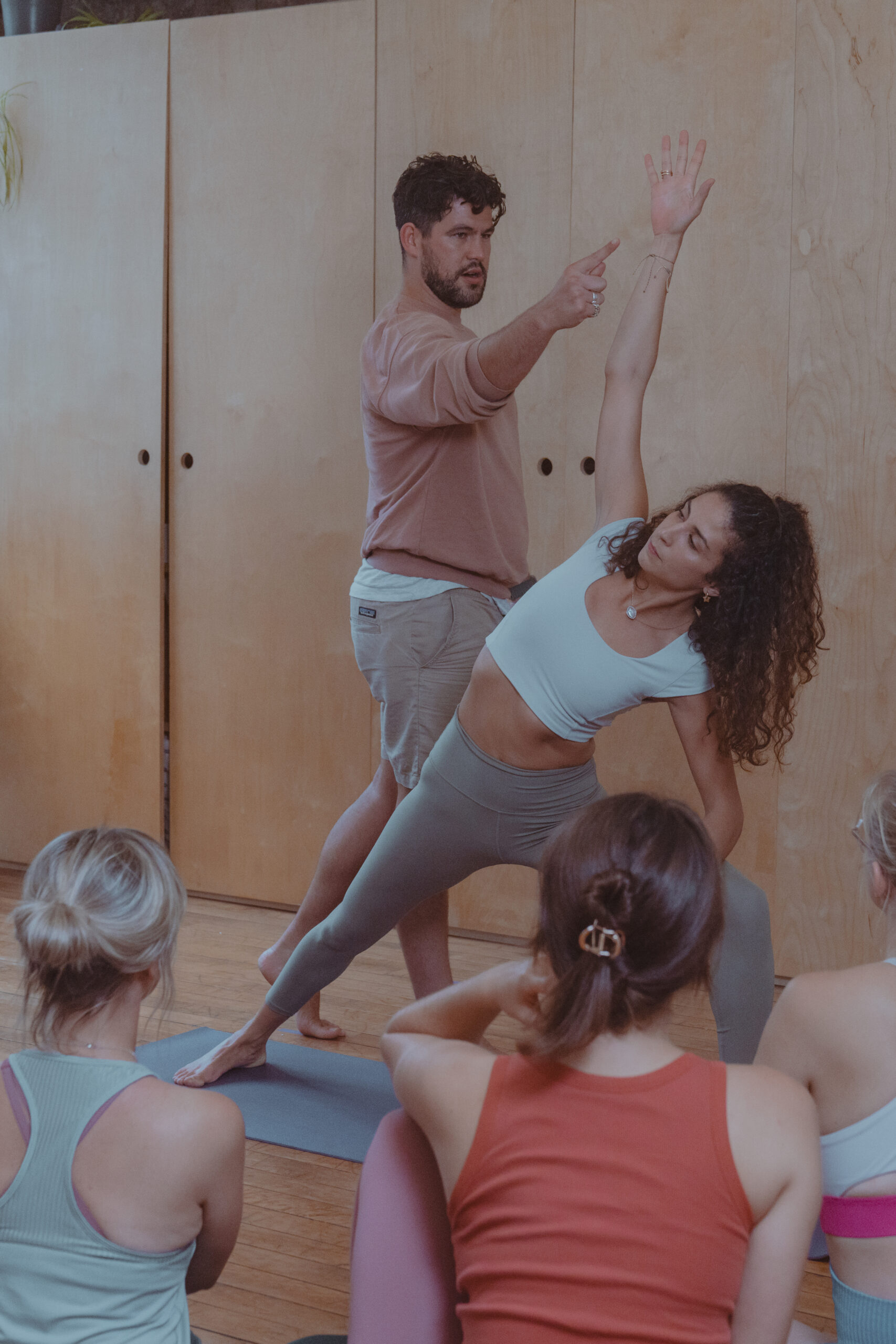During part one of yoga props: going beyond the ‘how to’ we touched on the history of props in the studio and learned about the student prop relationship from the perspective of Iyengar yoga.
Next we dive in to two slightly more modern styles of yoga – Vinyasa Flow and restorative. As mentioned in part one, we have pivoted the conversation from your usual ‘how to use yoga props’ to a more philosophical discussion. Here’s what we asked two triyoga teachers and Yogamatters, who provide many of the props you’ll find in our centre shops:
– Often times students view using props as a sign of weakness. Why should using props not be seen as a weakness? How do you change their perspective and spin it into a positive experience?
– What is missed when a student is not using a prop?
Yoga props: a Vinyasa perspective
Alex came to yoga as a result of a physical injury but stayed for the mind, body and soul exploration. Ever since, his practice and teaching have been about getting present though body and breath awareness as a way to decrease suffering and increase joy.
For Alex, working with students to break down prop preconceptions begins within the very first moments of class:
“In the first years of my own yoga practice if the teacher would instruct us to get a strap, two blocks and a bolster, my heart would sink. I’d convince myself it would be one of “those” classes where we wouldn’t move fast enough or worse I’d fumble with the strap and look like a fool. The irony is not lost on me that now as a teacher I almost always have students gather the whole range of props before settling on their mats and make use of them frequently during class.
“In the Vinyasa and Hatha classes I teach, the use of props will be incorporated from the very beginning – a few minutes or more of a supported savasana like reclining pose. Bolsters and blocks will prop up the hips, open the mid and upper back and support the head. Straps and blocks can open the groins and inner thighs in a way that create openness without the drama or strain that would be experienced without the props.
“By using the props so early in the class in a restorative yet intentional manner, they become an integral part of the experience. By holding this initial pose for some minutes, the student has time to feel the effects of using blocks, particularly greater openness and support in a way that encourages self-exploration and experiencing the body in a deeper way.
“I encourage students to be just that – students. Curiosity and willingness to learn new things are part of the joys of being a student. Practising with props is part of that journey of learning new things and ways of practising. If we broadly define yoga as “awareness”, props can help us to become more aware.”
As for what Alex thinks is missing when a student is not using a prop:
“Part of the human condition is to establish routines that, if we are not careful, turn into ruts that are hard to break free from. We get into patterns of being and moving that at the very least become automatic and worse lead us to injury. Props can be a way of establishing new ways of being, breaking old established habits and, by doing so, soaring to new possibilities in our practice and how we approach life.
“While resiliency and self-reliance are certainly good traits in measure, too much of them lead to obstinacy and close mindedness. Using props in our practice is a sign of humility and ultimately strength. By using props, we are putting into action the notion that placing as equal an emphasis on ease as on effort leads to a well-balanced practice and well-balanced lives.”
Yoga props: a restorative perspective
Ali Masterman is a compassionate and insightful yoga teacher, she teaches everyone from children to adults and specialises in pregnancy, post-natal and restorative classes. Her classes have a wonderful community atmosphere supporting her students emotional and physical development with warmth and empathy.
Ali shares her thoughts on students and props from a restorative perspective:
“As a restorative teacher I use props all the time. I encourage every student to spend time positioning props well and getting comfortable. They discover they can hold the postures for longer which allows their nervous systems to settle and that brings a sense of calm to body and mind. After they have experienced that they tend to be keen to use the props again.
“In a general yoga class, it’s about showing how much we can gain in a posture using them. Props were introduced into our yoga practice as an aide to assist our bodies and gain more from the poses. Not everybody fits every pose and the use of props can be hugely helpful.
“It is quite hard to change the mindset of some students. They feel that they are failing by using props.
“Sometimes I might use props for the whole class thus not excluding anyone and helping each student discover how much more they can gain individually. Using bricks for certain standing poses like trikonasana and uttanasana can be really helpful. Similarly foam blocks for seated poses. I find, by including and involving everyone, they actively choose the prop the next time they approach a pose, rather than struggling and pushing themselves into something that is not working for their body.”
Yogamatters on why yoga props matter
Yoga props are available for students to use in class at all triyoga centres free of charge. You’ll find mats, bolsters, belts, blocks and eye pillows ready and waiting to serve you and your higher self – most often in our triyoga purple, of course. Our in-centre retails shops offer these essentials for purchase as well as a wider selection of yoga props, including items such as meditation cushions, singing bowls and mat towels – many of which are from Yogamatters.
Given the same questions as our teachers, Sophie Safrazyan, Key Accounts at Yogamatters shares a bit more about how they view the student prop relationship:
“Props are there to give you space during your practice. Whether that is by lifting the floor during standing poses, to help lengthen and reach or to support during deep relaxation, props are always there to help deepen and support you.
“Ridding the stigma that props are a sign a weakness is where the practice of yoga really begins. Withdrawing from the ego and meeting yourself exactly where you are, even if it is different to the week or day before, with acceptance and non-judgement is where the practice of yoga can start to challenge us.”
She speaks to what is missing when props aren’t used:
“Without props, restorative yoga (for example) would be a totally different experience. To be held and fully supported by the props is where the magic of a deeply nourishing practice comes into play. It is difficult to get the full experience of completely allowing the body to come to a place of ease without some of our trusted favourites.”
So, where do you stand when it comes to props? Are you quick to refuse the support of a block or bolster? Would your body find more freedom and space in a pose if you bypassed preconceived stories of weakness and grabbed for a strap? Next time you’re preparing your space at the start of a class, check in with yourself and your teacher – a few props may make all the difference.
Click here to attend a yoga class with Alex Benasuli.
Click here to attend a restorative class with Alison Masterman.










